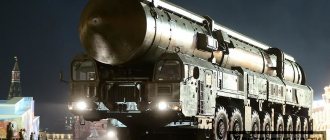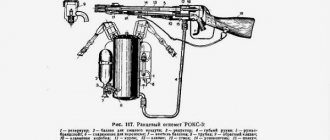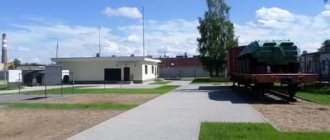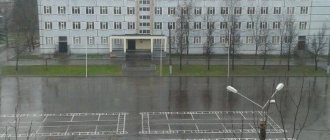Kapustin Yar test site or KapYar for short ) is part of the Armed Forces of the Russian Federation as the 4th State Central Interspecific Test Site (4th GSMP), being one of the oldest and most famous Russian missile test sites.
It was from the Kapustin Yar test site that the history of the creation of the Soviet strategic missile shield began. It is rightly called “the cradle of the Strategic Missile Forces.” Kapustin Yar is not only a missile test site, but also the largest testing and research center, as well as a cosmodrome. Despite the fact that this object was initially created for purely military purposes, it is difficult to overestimate its importance for civilian cosmonautics - both Soviet and modern Russian.
In this article we will touch on the history of the creation of the Kapustin Yar training ground and the most significant events associated with it, and also consider the current state of the training ground: its purpose, characteristics, deployed units and units.
HISTORY OF THE KAPUSTIN YAR POLYGON
The creation of the USSR nuclear missile shield began immediately after the end of the Great Patriotic War. The victory over Nazi Germany gave Soviet specialists access to part of the rocket technology of German scientists under the leadership of Wernher von Braun, who, together with a group of developers and designers, ended up in the zone of occupation of the American military and agreed to continue their work in the United States.
When advanced Soviet units appeared on the ruins of the Third Reich missile center near the town of Peenemünde, all the most valuable equipment, including several dozen ready-made V-2 missiles, had already been captured by the Americans and taken to the United States. However, the remains of technical documentation provided Soviet specialists with enough information to reproduce the design of the V-1 and V-2 missiles. In the USSR, several research institutes and design bureaus were urgently formed, which were closely involved in solving this problem.
The USSR had just ended the war, having experienced terrible destruction. It was impossible to allow the loss of military parity with the West. Any lag behind the United States in the field of nuclear weapons and their means of delivery threatened the loss of the state's defense capability. To conduct research and testing of missile weapons, it was necessary to create a specialized testing ground.
The history of the missile test site, and then the Kapustin Yar cosmodrome, began in May 1946, when the USSR Council of Ministers adopted a resolution on the creation of an entire network of design bureaus and institutes focused on the accelerated creation of strategic missile weapons. And for its testing, it was decided to create a specialized testing ground.
A group of specialists examined seven promising areas and, ultimately, chose a flat place near the village of Kapustin Yar in the Astrakhan region for the location of an important strategic facility.
The decision to build a test site in Kapustin Yar was made by a joint resolution of the Central Committee of the All-Union Communist Party of Bolsheviks and the Council of Ministers of the USSR on June 3, 1947. Given the importance of this facility, the management of the construction of the test site was entrusted to the State Commission, the chairman of which was appointed People's Commissar and Minister of Armaments of the USSR Dmitry Fedorovich Ustinov; The commission included the Chief of the General Staff of the USSR Armed Forces, Marshal of the Soviet Union A.M. Vasilevsky, Chief Marshals of Artillery N.N. Voronov, M.I. Nedelin, Marshal of Artillery N.D. Yakovlev and others. Construction was headed by Marshal of the Engineering Troops M.P. Vorobiev.
IN AND. Voznyuk - the first head of the test site |
The first head of the Soviet missile range was appointed Guard Lieutenant General (later Guard Colonel General) of Artillery V.I. Voznyuk. We should dwell in more detail on the personality of this man, who is rightly called the “founding father” of the test site.
Vasily Ivanovich Voznyuk was born on December 20, 1906 (January 1, 1907 according to the new style) in a family of actors of the Kharkov Drama Theater. In his youth he managed to work as a prompter, stagehand, and sailor, but since 1925 he connected his life with the armed forces, enrolling in the 1st Leningrad Artillery School named after Red October. From 1929 to 1937, he successively went through the steps of his career in the 30th Artillery Regiment: from platoon commander to chief of staff of the regiment and acting regiment commander. In 1938-1939 teaches at the Penza Artillery School, simultaneously acting as division commander of this school.
From the very beginning of the Great Patriotic War, he was at the front: first as chief of staff of the 7th Anti-Tank Brigade, then head of the operations department of the artillery headquarters of the 13th Army. One must think that during his service in these positions V.I. Voznyuk earned the exceptional trust of the command, so his entire further service during the Second World War was associated with the BM-13 guards mortar units, the famous Katyushas, which at that time were one of the newest and most formidable types of weapons of the Red Army. He served as chief of staff of guards mortar units of various fronts, from 1944 to June 1945 - deputy commander of the artillery of the 3rd Ukrainian Front for guards mortar units, and then - deputy commander of the artillery of the Southern Group of Forces (Austria) for guards mortar units.
Being the permanent head of the Kapustin Yar test site for 27 years, V.I. Voznyuk achieved its transformation into the largest testing and research center. Former subordinates remember him as a strict commander, a tireless builder, and the true owner of the training ground. Voznyuk did not take personal time into account when it came to the interests of the service, and demanded the same from his subordinates. There was a lot of work, including night work. Vasily Ivanovich liked to answer complaints from landfill employees about irregular working hours: “We have an eight-hour working day at the test site: eight hours before lunch and eight hours after.”
However, the “founding father” of the test site cared not only about missiles, but also about the city of Znamensk, the administrative center of the test site. KapYar military personnel and their families lived here. Built on waste salt marsh lands, the city stood out with lush greenery. All residents, from schoolchildren to military personnel, took part in the struggle for landscaping. Landscaping competitions took place between neighborhoods and courtyards. Voznyuk personally walked around the streets and courtyards, checked their condition, and talked with residents. All proposals and wishes were recorded by the adjutant, and subsequently found implementation. For Vasily Ivanovich there were no trifles. The needs of people, their way of life, were no less important to him than missile tests.
The “founding father” of the Kapustin Yar test site retired in 1973, three years before his death. In accordance with the will of V.I. Voznyuk, he was buried in the city of Znamensk. And all his awards were transferred to the museum of Dnepropetrovsk, where V.I. spent his youth. Voznyuk.
But let's return directly to the history of the test site.
Construction of the Kapustin Yar training ground began on August 20, 1947. The test site was intended for test launches of the first combat ballistic missiles, the launch of geophysical and meteorological satellites, as well as small space objects.
The first officers arrived at the construction site of the training ground in August 1947. And already in September, a special-purpose brigade of the Reserve of the Supreme High Command was sent there under the command of Major General of Artillery A.F. Tveretsky, which delivered two special trains with special rocket and telemetry equipment from Germany.
By the beginning of October 1947, in addition to the concrete test stand, a launch pad with a bunker, a temporary technical position, an assembly building, a bridge, and a warehouse for rocket fuel were built. Subsequently, a highway and a 20-kilometer railway line were built connecting the training ground with the main highway to Stalingrad (now the city of Volgograd).
Living at the training ground, especially at first, was incredibly difficult. They built a lot, but the military personnel and builders themselves had to live in the bare steppe in tents and dugouts, some were quartered in the huts of the village of Kapustin Yar. The management of the test site was located on a special train. It was necessary to prepare the test site for missile testing as quickly as possible, and there was simply no time left for housing construction. The first living quarters for the landfill personnel began to be built only in 1948.
On October 1, 1947, V.I. went to Moscow. Voznyuk reported to the country's leadership about the readiness of the test site for testing, and after 2 weeks, on October 14, 1947, the first batch of A-4 (V-2) missiles was delivered to the test site and a group of designers headed by S.P. arrived at the test site. Korolev.
On October 18, 1947, under the leadership of Korolev, at 10:47 a.m. Moscow time, the first ballistic missile launch in the USSR was carried out. It rose to a height of 86 kilometers and fell in the target area 274 kilometers from the start, deviating to the left of the director by 30 km. The target was considered to be a square measuring 40 by 40 km, so the tests were successful.
A year later, on October 10, 1948, the first domestically produced ballistic missile R-1, launched from the Kapustin Yar test site, opened the rocket and space era in the USSR. The successes of Soviet designers made it possible to create missile weapons for the Armed Forces of the Soviet Union in a very short time. For 10 years (from 1947 to 1957), Kapustin Yar became the only testing site for Soviet ballistic missiles. The site tested missiles from R-1 to R-14, the intercontinental Burya missile, the last Cold War missile RSD-10, the Scud missile, many other short- and medium-range missiles, cruise missiles, complexes and missiles Air defense.
At the same time, KapYar began to be used as a launch site for geophysical and then meteorological rockets. In June 1951, the first series of rocket launches with dogs on board took place here.
However, the main purpose of the test site was to test combat missile systems. On February 20, 1956, a nuclear missile weapon was tested at the Kapustin Yar test site: an R-5 rocket delivered a warhead to a specified area of the Astrakhan steppe, where a nuclear explosion occurred. In the early 50s, along with missile test launches, the formation and development of the test site's testing base continued. Launch and technical complexes are being built. In September 1958, single and group launches of all available types of missiles were carried out from the test site. The advantages of the centralized use of missile weapons were demonstrated to the arriving leadership of the USSR. The result was the adoption of a historic decision to create the Strategic Missile Forces.
In subsequent years, a large number of different short- and medium-range missiles, cruise missiles, complexes and air defense missiles were tested at the test site. Since the early 1950s. At least 11 aerial nuclear explosions were carried out at the Kapustin Yar test site at altitudes from 300 m to 5 km.
In the early 60s, medium-range missiles were tested at the test site: the R-14 and its silo version R-12, which formed the basis of the country's missile shield in the 1960s - 1980s. For testing the R-12 rocket, the Kapustin Yar test site was awarded the Order of the Red Star.
Since the beginning of the 60s, space exploration has become another area, no less important than missile testing. In the shortest possible time, the personnel of the test site mastered the technology for preparing the launch of spacecraft. The Kapustin Yar test site received the functions of a cosmodrome on March 16, 1962 - on this day the first small research satellite “Cosmos-1” was launched into Earth orbit, marking the beginning of serial launches.
On October 14, 1969, the Intercosmos-1 satellite, created by specialists from socialist countries, was launched, and the Kapustin Yar cosmodrome acquired international status. The Indian satellites Aryabhata and Bhaskara, and the French one, Snow-3, took off from its launch pads.
For two decades, the Kapustin Yar cosmodrome became the launch site for “small” satellites for scientific and economic purposes. As specialized ranges for launching such satellites were built, the need for such launches gradually decreased, and in 1988 they were discontinued from the launch complexes of the Kapustin Yar cosmodrome.
In connection with the signing of the 1987 Treaty on the Reduction of RSD Missiles at the test site, testing work was almost completely stopped. The starting and technical positions were mothballed, although they were left in working condition. They were not used for the next 10 years.
Perestroika and the chaos of the 90s led to a significant reduction in the volume of testing work at the test site. For the KapYar command during this difficult period, the main thing was to preserve the unique personnel of missile systems testers. The management of the training ground “fought” for each of its units, trying to protect them from layoffs. After all, it would be very difficult to restore what was lost later.
Test launch of a ballistic missile from the Kapustin Yar test site |
The revival of the test site and cosmodrome began in October 1998, when the 4th State Central Test Site was transformed into the 4th State Central Interspecific Test Site (4 GCMP).
Testing of new models of missile technology for various purposes resumed at the test site (in 1999, the Emba and Sary-Shagan test sites were relocated to Kapustin Yar).
After many years of inactivity, in 1998 the Cosmos 11K65M launch vehicle was commercially launched from the cosmodrome, which put a French satellite into orbit, and in 1999 two more research satellites were launched under international cooperation programs.
With the beginning of the 21st century, the Kapustin Yar training ground again became in demand for military purposes.
In particular, repeated tests of the S-400 Triumph air defense system took place at the test site. On July 12-13, 2007, two targets were successfully hit: one at a speed of 2800 m/s, and the second at an altitude of 16 km. On March 2, 2015, during live firing using the S-400 air defense system, target missiles simulating modern air attack weapons were also successfully hit.
In 2005, a training launch of the RT-2PM missile of the Topol complex was successfully carried out from the Kapustin Yar test site, in March 2014 the RS-12M Topol ICBM was launched, and on March 26, 2015, information appeared in the media about the successful test launch of a small-sized ICBM with increased shooting accuracy of the RS-26 Rubezh.
In 2007, the R-500 cruise missile for the Iskander-K OTRK was tested at the test site. And in October 2011, tests of the Iskander-M OTRK took place.
At the beginning of 2015, representatives of the Russian Ministry of Defense announced the upcoming testing of combat robotic systems for the Strategic Missile Forces at the test site. In this regard, one of the final stages of preparatory work is being carried out, which consists of modernizing the KapYar data transmission system, which will create a unified information space for the test site. It is planned to test mobile and stationary combat robotic systems responsible for the remote-controlled deployment of unmasking and signaling equipment, such as various beacons and sensors.
© Material prepared for the portal “Modern Army” https://www.modernarmy.ru
Scientific research
Even during the first series of launches in October - November 1947, Kapustin Yar began to be used as a launch site for geophysical rockets. The A-1 rocket, launched on November 2, 1947, was equipped with scientific instruments. From then on, this tradition was maintained until specialized geophysical rockets V-1 and V-2 were created. However, Kapustin Yar remained the launch site for geophysical rockets. Later, meteorological rockets were added to geophysical rockets. In June 1951, the first series of rocket launches with dogs on board took place.
STRUCTURE AND TASKS OF THE RANGE TODAY
The Kapustin Yar test site is located in the Astrakhan region, near the village of Kapustin Yar in the lower reaches of the Volga. The area of the Kapustin Yar landfill is 650 square meters. km. Part of the landfill territory is located on the territory of Kazakhstan.
The administrative and residential center of the test site is the city of Znamensk with a population of about 32 thousand people. The city is a closed administrative-territorial entity (ZATO). Initially, the town where the military lived was built up with Finnish houses; permanent buildings appeared in 1951. Until 1962, it was simply called Kapustin Yar-1, and Znamensk received the status of a city and its current name on January 11, 1962. Since that time, the city has had Intensive construction of residential buildings and infrastructure has begun. The city received the status of a closed city on July 14, 1992.
Currently, the Kapustin Yar test site faces a number of complex and important tasks that determine its prospects. This:
- testing new measuring systems based on space technologies;
- formation of a control and measurement base for carrying out docking and adjustment work on strategic missile systems;
- testing of aerospace defense systems;
- testing of missile defense systems;
- testing new systems and missiles for operational-tactical purposes;
- participation in large-scale combined arms exercises with live firing (one of the new tasks previously not typical for the training ground).
Currently, within the structure of the Kapustin Yar test site, there are four main research and testing units of weapons and military equipment: the Strategic Missile Forces, the Air Defense Forces, the Air Defense Forces of the Ground Forces, and the Missile Forces and Artillery. The main element of the test site is the experimental test base, which includes command posts, technical launch positions, measuring equipment and other components.
The following military units are stationed on the territory of the Kapustin Yar training ground:
- military unit 10837 – logistics base;
- military unit 15644 – 4th State Red Banner Order of the Red Star, central interspecific training ground of the Ministry of Defense of the Russian Federation;
- military unit 15646 – 261st scientific testing center;
- military unit 15683 – support division;
- military unit 21065 – 788th Scientific Testing Center for Armaments and Military Equipment of the Strategic Missile Forces;
- military unit 29139 – 708th research and testing center for interspecific air defense systems;
- military unit 31926 – 20 OIS;
- military unit 33763 – 23rd separate guard battalion;
- military unit 33782 – 35th separate mixed aviation squadron;
- military unit 33901 – railway battalion;
- military unit 39216 – communications regiment;
- military unit 42202 – 60th Order of the Red Star Training Center for Combat Use of the Missile Forces of the Ground Forces;
- military unit 47209 – training division of the Missile Forces;
- military unit 48315 – 439th Guards Perekop Order of Kutuzov rocket artillery brigade of the Ground Forces;
- military unit 52910 – 30th separate engineering testing unit;
- military unit 54003 – 88th aviation commandant’s office;
- military unit 74322 – 118th scientific testing center;
- military unit 75376 – Federal State Educational Institution of Secondary Vocational Education “161st School of Strategic Missile Forces Technicians.”
Let's take a closer look at some of them.
Military unit 15646
Military unit 15646 (1st Directorate) was formed on September 2, 1946 to solve the problems of testing rocketry, that is, it is one of the main parts of the test site. It is staffed by engineering and technical personnel who directly carry out test launches of missiles at the test site.
Depending on the types of missile technology being tested, the organizational structure of military unit 15646 underwent changes at different times. In 2000, the 1st Directorate and the testing center subordinate to it were transformed into a single structure - the 261st Scientific Testing Center.
From the first launch of the A-4 to the launch of the Topol-M rocket, this is the path of the test engineers of military unit 15646. Behind them are thousands of launches of strategic missiles and launches of spacecraft for military and scientific purposes.
Military unit 21065
A significant share of testing work falls on the 788th Scientific Testing Center, which was formed as a result of the merger of the 11th State Emba Test Site, the 2nd Test Directorate for Tactical Missile Systems and the 34th Engineering Test Unit.
In 1999, the personnel of the center in the bare steppe had to create a testing base in a short time. The main specialization of the 788th Research and Test Center is currently testing and research in the field of creating tactical and operational-tactical missile systems, reconnaissance and strike systems, anti-aircraft missile systems and military air defense systems, combat control and communications systems.
One of the main areas of work. After the completion of state tests of the Iskander complex in 2004, experiments are being carried out here with modernized control and guidance systems of the complex, and the creation of new classes of missiles.
Also, the center’s specialists make a great contribution to the refinement and modernization of the S-300VM air defense systems, the Buk and Tor air defense systems, and the Smerch MLRS.
Military unit 29139
A special air defense test site, now the 708th Research and Test Center, was created in 1951 to test the first Soviet anti-aircraft missile system, the S-25 Berkut.
During its existence, the center tested many samples of anti-aircraft missile weapons, automation and radar equipment, which made it possible to solve problems of national importance in the protection and defense of the country's air borders. The center's specialists carried out more than 25 thousand launches of anti-aircraft missiles and target missiles, and tested 200 samples of rocket technology.
Today the center is carrying out work to improve tactical and technical missile weapons in the interests of all types and branches of the military.
Military unit 52910 and military unit 74322
Test site measuring equipment |
Measuring missile trajectories is the most important type of work during test launches. The very first launches at the Kapustin Yar test site were carried out by officers armed with German film theodolites. Telemetric measurements were also made using captured equipment. All tasks of processing and deciphering data were assigned to the settlement bureau, the main equipment of which was slide rules and the first adding machines.
In 1962, on the basis of the measuring units of the testing units, the 3rd Department of Measurements and Mathematical Processing and the 30th Separate Engineering Testing Unit were formed. The scale of the measurement work is evidenced by the geography of the units subordinate to the 3rd Directorate: 29 units dispersed from KapYar to Balkhash and Bratsk. The intensity of the work was so great that the measuring departments and the computer center worked around the clock.
By the beginning of the 21st century, the modern appearance of the measuring complex had developed at the test site. To better carry out measurements during testing of new weapons, the 118th research and testing center was formed on September 1, 2001. The entire system of collecting and processing measurement information has moved to a new level. It united measuring points, computer complexes of the computer center, automated analysis and assessment points, and command posts into a single information network. New technologies using satellite communication channels and unique software developed by the center’s specialists made it possible to display the flight path of the test product in real time.
Over the more than 50-year history of the center, its personnel have provided measurements and calculations for thousands of launches, and put into operation several generations of computing and measuring equipment.
10th State Research Test Site Sary-Shagan
It is one of the main compounds of the 4th HCMP.
It was created in 1956 on the territory of the Republic of Kazakhstan. Located northwest and west of the lake. Balkhash. Connected by a highway to the Kapustin Yar training ground. Currently, the territory of the test site is leased by the Ministry of Defense of the Russian Federation.
Sary-Shagan is unique in that it is the only test site in Eurasia for testing anti-missile weapons systems. Also, the personnel of the test site made a significant contribution to testing the combat equipment of missiles of strategic equipment systems.
During the existence of the test site, more than 70 missile defense systems and more than 20 types of interceptor missiles were tested there. In the 60s – 80s, missile defense systems based on new physical principles were tested at the test site (projects “Terra” and “Omega” to create domestic combat lasers).
Military unit 33763
Military personnel of the range security battalion |
The guard battalion was formed in 1946 from front-line soldiers. Throughout the existence of the training ground, the battalion personnel solved the most important tasks of ensuring the security of the training ground, performing checkpoint and commandant duties.
Military unit 33782
The 158th mixed air regiment was formed in 1959. To ensure testing, the pilots carried out drops of targets for anti-aircraft guided missiles, flights with control and measuring equipment, and searched for detachable parts of missiles. Currently, the regiment has been transformed into the 35th separate mixed squadron. It is armed with An-72, An-26 aircraft and Mi-8 helicopters. The squadron is based at a military airfield near the city of Znamensk (Kapustin Yar airfield).
Military unit 33901
The railway battalion was formed in 1968, but the history of the railway workers of the range began much earlier, with the laying of the first railway lines. An entire railway network was created connecting the landfill sites. Military railway workers service four stages (about 50 trains are carried annually), carry out routine repairs of railway tracks and maintenance of the locomotive fleet of the training ground, and constantly maintain the combat readiness of the rolling stock.
The international cooperation
Since October 14, 1969, Kapustin Yar has operated as an international cosmodrome. On that day, the Intercosmos-1 satellite, created by specialists from socialist countries, was launched. The Indian satellites Aryabhata and Bhaskara and the French satellite Snow-3 took off from Kapustiny Yar. Kapustin Yar played a major role in training qualified personnel for testing rocket and space technology and management personnel for new cosmodromes.
The Kapustin Yar cosmodrome took on the role of a cosmodrome for “small” rockets and “small” Earth satellites for research purposes. This specialization existed until 1988, when the need for launches of such satellites sharply decreased and space launches from the Kapustin Yar cosmodrome ceased.
Information for mom
Parcels and letters
Unit address: 416540, Astrakhan region, ZATO Znamensk-3, military unit 47209, full name of the soldier, unit letter: K for the 1st battery, S for the second and L for the third. Post office address: 416540, Astrakhan region, ZATO Znamensk-3, st. Lenina, 42 The department is open from Monday to Friday from 8.00 to 20.00, on Saturday from 9.00 to 18.00, on Sunday from 9.00 to 14.00. Soldiers receive letters and parcels once a week.
Sports ground and sports corner
Contact phone numbers
7 (851-40) 9-71-71 – part switch; 7 (851-40) 2-50-70 – unit on duty; 7 (851-40) 9-71-59 – State Central Interspecific Test Site Kapustin Yar; 7 (85140) 2-30-59 – pass office of ZATO Znamensk; 7 (851-40) 2-39-67 – city head of ZATO Znamensk; 7 (851-40) 2-39-34 – city administration; 7 (851-40) 2-25-03 – hospital (located on the territory of military unit 33670); 7 (851-40) 4-12-97 – therapeutic department of the clinic of ZATO Znamensk; 7 (851-40) 2-56-68 – military prosecutor’s office of the Znamensky garrison; 7 (851-40) 2-30-52 – post office phone number; 8 – “Autoline” (trips from Volgograd to Znamensk); 8 – “Noah” (trips from Volgograd to Znamensk); 8 – “Green-light” (trips from Astrakhan to Znamensk)
Parade ground of the unit
Oath to military unit 15644
Soldiers serve on the physical territory of the training ground, and are brought to the combat unit of Znamensk to take the oath. Here this event is held solemnly on Lenin Square on Saturday morning, namely at 9:00.
It is necessary to take into account that in the Astrakhan region the time is +1 hour Moscow time, in Volgograd - Moscow time.
Soldiers arrive well in advance for the oath, but you are not allowed to communicate until the oath is over; you should not even wave to a soldier so that he notices you. The location of the relatives at the oath is quite remote from the soldiers, so it is better to take a photo device with a good zoom. At the moment the oath is read by a soldier, one relative is allowed to approach for close-up photography. At the end of the event, servicemen are given 10 minutes to take a photo with their relatives.
After taking the oath, the soldiers are led to the unit, from where they will be taken to the training ground in 1-2 days. Soldiers are not on allowance in the Znamenskaya military unit, where the administrative apparatus of the 4th GCMP is located, so when taking them on leave, you need to feed them, taking into account the lack of food upon return. The soldier is handed over to relatives in exchange for a passport; on Saturday the soldier must return to the location before 19:30, and on Sunday before 17:00. The serviceman is not allowed to put a lot of food when they are taken to the training unit; at most they will be allowed to eat everything at the first dinner. You can put some sweets and gingerbreads, but non-perishable foods, they won’t be allowed at the checkpoint.










